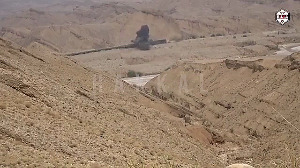A space expert has suggested setting up a system, on the lines of the tsunami warning system, to give advance information about asteroids approaching very close to the earth.
Though the chances of a deadly asteroid hitting the earth is one in a thousand this century, we need to keep a close watch on the objects flying very close to the earth, William Ailor, Director of Centre for Orbital and Reentry Debris Studies at the The Aerospace Corporation, US, said in Hyderabad on Monday.
He was speaking at the inaugural highlight lecture organised as a part of the ongoing 58th International Astronautical Congress (IAC). Ailor said there were about 3.5 lakh minor planets and approximately 4,500 near earth objects (NEOs) orbiting near our planet.
"And everytime an asteroid has flown near the earth, we have come to know only when it has passed by," he said.
Of the 4,500 NEOs, approximately 830 have been classified as potentially hazardous objects which are larger than one km in diameter and can fly "really close to the earth".
"We need a system, on the lines of tsunami warning system, to give us advance warnings of an approaching object," he said. Such a system should be able to give information about the precise orbit of the asteroid, the impact probability on earth, size, mass, shape and the rotation rate as also its physical properties.
"Once we have advance information on NEOs approaching earth, a response can be planned to avoid potential disasters," he said adding such responses could entail launching of missions to the asteroid to deflect it from its orbit or triggering a nuclear explosion to destroy it in space.
"There is a necessity to include NEO disasters involving asteroids with a diameter between 50 metres and 140 m as a part of the disaster response programme chalked to tackle natural disasters," he said.
Ailor said asteroid Apophis was expected to come within 30,000 km of earth's orbit on April 13, 2029 and there was one in 45,000 chance of the object hitting the earth in 2036.
The 300-metre asteroid has the potential of triggering an explosion equivalent to that of a 850 mega tonne explosive.
He said the moon has a unique advantage of hosting a system to look into outer space for asteroids approaching the earth.
Asteroids have exploded very near to the earth's surface, the most prominent example being the incident in Tunguska in Siberia in 1908 when a 50-metre diametre object exploded about six-km above the earth's surface.
The June 30, 1908 incident, with a power of a 10-15 megaton bomb, flattened trees over 2000 sq km area and wiped off the reindeer population from a 400 sq km area. A similar incident occurred in Brazil on August 13, 1930.
Nuclear-detonation detection satellites, orbiting the earth, detected 136 atmospheric blasts in the megatons-of-TNT range between 1975 and 1992, Ailor said seeking to draw attention to the seriousness of the problem.







 © 2025
© 2025